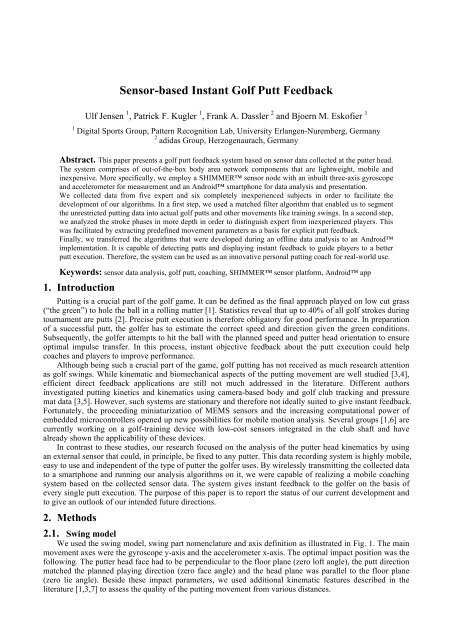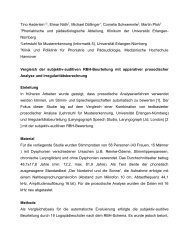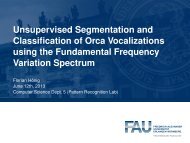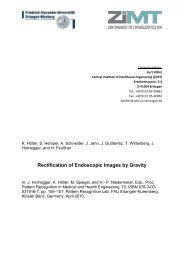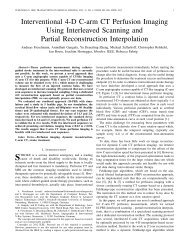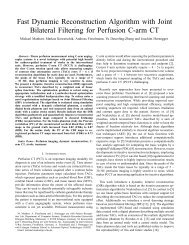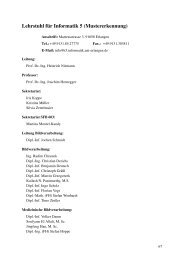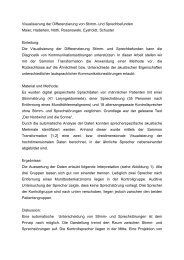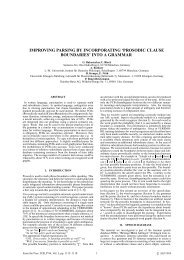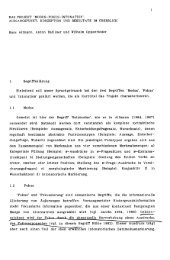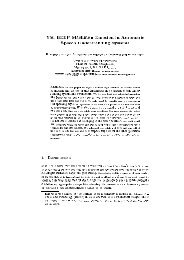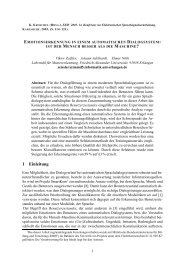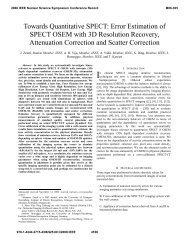You also want an ePaper? Increase the reach of your titles
YUMPU automatically turns print PDFs into web optimized ePapers that Google loves.
<strong>Sensor</strong>-<strong>based</strong> <strong>Instant</strong> <strong>Golf</strong> <strong>Putt</strong> <strong>Feedback</strong><br />
Ulf Jensen 1 , Patrick F. Kugler 1 , Frank A. Dassler 2 and Bjoern M. Eskofier 1<br />
1 Digital Sports Group, Pattern Recognition Lab, University Erlangen-Nuremberg, Germany<br />
2 adidas Group, Herzogenaurach, Germany<br />
Abstract. This paper presents a golf putt feedback system <strong>based</strong> on sensor data collected at the putter head.<br />
The system comprises of out-of-the-box body area network components that are lightweight, mobile and<br />
inexpensive. More specifically, we employ a SHIMMER sensor node with an inbuilt three-axis gyroscope<br />
and accelerometer for measurement and an Android smartphone for data analysis and presentation.<br />
We collected data from five expert and six completely inexperienced subjects in order to facilitate the<br />
development of our algorithms. In a first step, we used a matched filter algorithm that enabled us to segment<br />
the unrestricted putting data into actual golf putts and other movements like training swings. In a second step,<br />
we analyzed the stroke phases in more depth in order to distinguish expert from inexperienced players. This<br />
was facilitated by extracting predefined movement parameters as a basis for explicit putt feedback.<br />
Finally, we transferred the algorithms that were developed during an offline data analysis to an Android<br />
implementation. It is capable of detecting putts and displaying instant feedback to guide players to a better<br />
putt execution. Therefore, the system can be used as an innovative personal putting coach for real-world use.<br />
Keywords: sensor data analysis, golf putt, coaching, SHIMMER sensor platform, Android app<br />
1. Introduction<br />
<strong>Putt</strong>ing is a crucial part of the golf game. It can be defined as the final approach played on low cut grass<br />
(“the green”) to hole the ball in a rolling matter [1]. Statistics reveal that up to 40% of all golf strokes during<br />
tournament are putts [2]. Precise putt execution is therefore obligatory for good performance. In preparation<br />
of a successful putt, the golfer has to estimate the correct speed and direction given the green conditions.<br />
Subsequently, the golfer attempts to hit the ball with the planned speed and putter head orientation to ensure<br />
optimal impulse transfer. In this process, instant objective feedback about the putt execution could help<br />
coaches and players to improve performance.<br />
Although being such a crucial part of the game, golf putting has not received as much research attention<br />
as golf swings. While kinematic and biomechanical aspects of the putting movement are well studied [3,4],<br />
efficient direct feedback applications are still not much addressed in the literature. Different authors<br />
investigated putting kinetics and kinematics using camera-<strong>based</strong> body and golf club tracking and pressure<br />
mat data [3,5]. However, such systems are stationary and therefore not ideally suited to give instant feedback.<br />
Fortunately, the proceeding miniaturization of MEMS sensors and the increasing computational power of<br />
embedded microcontrollers opened up new possibilities for mobile motion analysis. Several groups [1,6] are<br />
currently working on a golf-training device with low-cost sensors integrated in the club shaft and have<br />
already shown the applicability of these devices.<br />
In contrast to these studies, our research focused on the analysis of the putter head kinematics by using<br />
an external sensor that could, in principle, be fixed to any putter. This data recording system is highly mobile,<br />
easy to use and independent of the type of putter the golfer uses. By wirelessly transmitting the collected data<br />
to a smartphone and running our analysis algorithms on it, we were capable of realizing a mobile coaching<br />
system <strong>based</strong> on the collected sensor data. The system gives instant feedback to the golfer on the basis of<br />
every single putt execution. The purpose of this paper is to report the status of our current development and<br />
to give an outlook of our intended future directions.<br />
2. Methods<br />
2.1. Swing model<br />
We used the swing model, swing part nomenclature and axis definition as illustrated in Fig. 1. The main<br />
movement axes were the gyroscope y-axis and the accelerometer x-axis. The optimal impact position was the<br />
following. The putter head face had to be perpendicular to the floor plane (zero loft angle), the putt direction<br />
matched the planned playing direction (zero face angle) and the head plane was parallel to the floor plane<br />
(zero lie angle). Beside these impact parameters, we used additional kinematic features described in the<br />
literature [1,3,7] to assess the quality of the putting movement from various distances.
Fig. 1: Left: schematic view of a golf putt. Adapted from [1]. Right: gyroscope Y-axis data view.<br />
Swing phases: 1: backswing, 2: forward swing, 3: impact and 4: follow-through.<br />
2.2. Mobile research platform<br />
Our putt coaching system built up on a research platform that we are using for mobile body area network<br />
applications. It consisted of SHIMMER sensor nodes [8] and an Android-<strong>based</strong> HTC Legend<br />
smartphone (HTC Corporation, Taoyuan, Taiwan).<br />
We used the gyroscope sensor module and the on-board accelerometer of the SHIMMER nodes in our<br />
study. Three-axis gyroscope data with a range of ±500 deg/s and three-axis accelerometer data with a range<br />
of ±1.5 g from a single sensor node mounted on top the golf club head was recorded with a frequency of 250<br />
Hz and transmitted via Bluetooth radio.<br />
We implemented our coaching software engine on a HTC Legend smartphone that ran Android<br />
Version 2.1 on a MSM7227 microprocessor (600 MHz) with 512 MB main memory. The resulting app was<br />
<strong>based</strong> on a communication software that was developed within our research group [9].<br />
2.3. Data collection<br />
We collected data from eleven subjects (1 female, 10 male) that were either experienced golfers (n=5) or<br />
completely unexperienced (n=6). One participant was a professional golfer. After individually warming up,<br />
each subject performed five consecutive putts from three different distances labelled as short (1m), mid (3m)<br />
and long (5m) on an even training green at the <strong>Golf</strong> Club Herzogenaurach, Germany. The subjects were not<br />
restricted to any behaviour or technique. We recorded the whole sequence of putts including training swings<br />
without hitting the ball and arbitrary movements. Each subject started the experiment with the shortest<br />
distance and finished with the longest. The experiment was then repeated with a variation in either the golf<br />
club or the ball.<br />
We used two mallet type putters, the TaylorMade (TaylorMade Inc. Carlsbad, USA) Spider and the<br />
Pro Ace (Pro Ace Ltd., London, UK) 20704. As golf balls, the TaylorMade Noodle Longest and Burner<br />
LDP were used. The variation was arbitrarily chosen and delivered two data sets of 15 putts for each subject.<br />
Three blocks of five putts were missing due to sensor malfunction so that we recorded 315 putts overall.<br />
Each actual putt was marked in the data set by an external manual trigger for segmentation validation.<br />
2.4. Preprocessing and initial segmentation<br />
The aim of this step was to extract stroke candidates and determine two major swing phases as defined in<br />
our swing model. As a preprocessing step, we applied a low-pass Butterworth filter of order 3 with a cut-off<br />
frequency of 8 Hz. The following two-step algorithm is <strong>based</strong> on the filtered data.<br />
First, we implemented a matched filter algorithm to roughly segment the signal in stroke candidates and<br />
other signals. In this approach, a template is correlated with a given signal to check for the presence of this<br />
template. Equation 1 shows the computation of the correlation value C for an M-dimensional signal x and the<br />
M-dimensional template b of length N. The factors α k<br />
scale each dimension for their contribution to the<br />
correlation value. The main movement axes of a golf putt contributed to the correlation in our algorithm. We<br />
calculated a template out of the ten short distance strokes of the professional golfer and reversed the resulting<br />
template to align the signals for the above-mentioned computation. The scaling factors were used to adjust<br />
the different value ranges of the axes. The € resulting C value was used together with an empirical threshold<br />
that was set by observation to identify a set of stroke candidates.<br />
€<br />
C =<br />
M N<br />
∑α k<br />
k =1 i=1<br />
∑ x( t − i)⋅ b( i)<br />
(1)<br />
Second, we determined the major swing phases in these candidates. They were the backswing (BS) phase<br />
on the one hand and the combined forward swing (FS), impact (IP) and follow-through (FT) phase on the
other hand. The instants of time that border these two phases were zero-crossings in the gyroscope y-axis<br />
data (Fig. 1, right).<br />
2.5. False stroke elimination and stroke segmentation<br />
We eliminated false stroke detections <strong>based</strong> on the stroke candidates and their corresponding stroke<br />
phases from the previous step. We used a two-stage approach including a plausibility analysis of timing and<br />
rotation speed and an impact check.<br />
In a first step, the plausibility analysis regarded the temporal ratio of BS to FS/IP/FT and the ratio of<br />
minimal backward to maximal forward rotation speed. The temporal ratio was <strong>based</strong> on typical putt timing<br />
from [1] while the rotation speed ratio was chosen to eliminate pendulum movements that violate our swing<br />
model. Strokes that did not fit in the predefined bounds were excluded from further analysis.<br />
In a second step, candidate strokes without a distinct high-frequency signal characterizing an impact<br />
event were excluded. In contrast to the previous segmentation stages, the unfiltered data was used. We<br />
created a characteristic pattern by analyzing the impact of all labelled FS/IP/FT phases. Our algorithm then<br />
searched the candidate stroke swing phases for this pattern. On absence of the pattern, the stroke was rejected<br />
from further analysis. Otherwise, the stroke was further segmented in forward swing, impact and followthrough.<br />
The impact duration was set to a constant value using typical stroke timing [1].<br />
Table 1: Overview of features computed for each golf putt<br />
Number Description Number Description<br />
1 Duration of BS 17 BS rotation angle<br />
2 Duration of FS 18 FS rotation angle<br />
3 Duration of BS and FS 19 FT rotation angle<br />
4 Duration of FT 20 Ratio of FS rotation angle to FT rotation angle<br />
5 Temporal ratio of FS to FT 21 Acceleration change in pre impact phase of accelerometer x-axis<br />
6 Temporal ratio of BS to FS 22 Acceleration change in post impact phase of accelerometer x-axis<br />
7 Duration of stroke 23 Rotation velocity of gyro y-axis at impact<br />
8-10 Summed rotation in BS and FS phase of gyro<br />
x-, y- and z-axis<br />
24 Horizontal velocity of accelerometer x-axis at impact<br />
11-13 Summed rotation in pre impact phase of gyro<br />
x-, y- and z-axis<br />
25-26 Acceleration maximum (x-axis) in FS (position, value)<br />
14-16 Summed rotation in post impact phase of gyro<br />
x-, y- and z-axis<br />
27-28 Velocity maximum (x-axis) in FS (position, value)<br />
2.6. Feature extraction<br />
The coaching feedback we provided is <strong>based</strong> on putt parameters. Our literature research revealed various<br />
parameters that characterize correct putts and also describe kinematic findings that distinguish expert from<br />
novice players. We built a set of 28 features (Tab. 1) that were computed for each putt. We defined the preand<br />
post-impact phases as ¼ of the forward swing and the follow-through, respectively.<br />
2.7. Coaching advices and putt score<br />
We gathered a set of eight coaching advices as putt feedback. Therefore, we analyzed the distribution of<br />
different parameter values and combined these findings with expert knowledge and our stroke model<br />
assumptions. See Tab. 2 for an overview.<br />
Beside the textual feedback, we introduced an overall putt score <strong>based</strong> on the coaching advice<br />
computation. Perfect fulfilment of an aspect results in two points and partial completion in one point. 16<br />
points could be reached for a stroke in total.<br />
2.8. Implementation<br />
The presented algorithms were implemented in a Matlab(The Mathwork Inc., Natick, USA) prototype.<br />
They served as the basis for porting the algorithms to Java software running on the device described above.<br />
3. Results<br />
The developed segmentation algorithm reached a false detection rate of 1%. The misdetections appeared<br />
in the shortest distance experiment parts. These patterns were manually excluded from further analysis. All<br />
stroke phases were recognized correctly according to our stroke model.<br />
We analyzed the mean score for the two population groups for all distances. The mean score was 13.4 (±<br />
2.4) for the experienced golfers and 11.4 (± 2.4) for the unexperienced subjects. The professional golfer<br />
reached the full score for every putt performed.<br />
The Android app proved to run on the target device. The device displayed the coaching advices, the<br />
score, the backswing rotation angle and the horizontal impact speed of a detected putt.
Table 2: List of possible single-stroke coaching advices and related features<br />
Advice Features Advice Features<br />
Stroke with a larger follow-through! 20 Face plane not perpendicular to the ground! 9<br />
At impact: slide the putter head and stir more vertical! 27 Strike the ball with putter head plane parallel to the ground! 8<br />
Do not decelerate in the forward swing! 23 Do not twist the club just before impact! 11,13<br />
Face plane not perpendicular to stroke path! 10 Do not twist the club just after impact! 14,16<br />
4. Discussion<br />
The matched filter approach proved to be appropriate for detecting strokes. The fact that a single<br />
template was sufficient for detecting strokes from various distances resulted in a moderate computational<br />
complexity suitable for a mobile device with limited computational power. Visual inspection revealed that<br />
the three misdetections were random movements generating a putt like pattern and only appeared in lowdistance<br />
putts. Hence, the algorithm might be capable of handling putts from higher distances without or<br />
with only minor changes.<br />
Inertial sensors can determine relative position data at rest <strong>based</strong> on the earth’s gravity field. A proper<br />
golf putt address includes a resting position with zero lie, loft and face angle. However, the study participants<br />
were absolutely free in their accomplishment and did not start in the assumed address position. The relative<br />
impact angles were therefore determined indirectly due to the motion nature in both address and impact.<br />
The feedback in textual form delivered specific advices for golf putt improvement. This coaching<br />
regarded the putt execution and was independent from stroke distance. The provided score was an easy tool<br />
to estimate the quality of the putt and proved to distinguish unexperienced from experienced subjects. The<br />
golfer is also able to train repeatability with the displayed backswing angle and impact velocity output.<br />
The system we developed is <strong>based</strong> on lightweight, inexpensive and commercially available hardware<br />
components. The sensor node can easily be mounted on different kinds of putters and the smartphone fits in a<br />
pocket or golf bag. Therefore, our training system is usable for multi-player and outdoor use, can be mounted<br />
on different putters and easily be controlled with a touch screen.<br />
5. Outlook<br />
So far, the differences of experienced and completely unexperienced golfers were investigated. A stroke<br />
model and the knowledge of experts guided this process. The authors are planning a data-driven evaluation<br />
of differences in putt execution between experiences and unexperienced players. Therefore, we will use<br />
pattern recognition methods <strong>based</strong> on the presented features. Together with a feature reduction approach, this<br />
could deliver a data view on the main differences in stroke execution.<br />
We also collected data about the final position of the golf ball after stroke execution during the<br />
experiments. Correlating stroke execution parameters and stroke result will also be highly interesting.<br />
6. Acknowledgements<br />
The authors would like to thank the <strong>Golf</strong> Club Herzogenaurach e.V. for allowing access to their training<br />
green for the purposes of our study. We also thank Felix Durlak and Sandra Tüxen for assistance during<br />
experiments and all participants who volunteered in the study.<br />
7. References<br />
[1] R. Burchfield, and S. Venkatesan. A Framework for <strong>Golf</strong> Training Using Low-Cost Inertial <strong>Sensor</strong>s, Proc. of<br />
the International Conference on Body <strong>Sensor</strong> Networks (BSN 2010). Singapore. 2010, pp. 267-272.<br />
[2] S.J. Mackenzie, and D.B. Evans. Validity and reliability of a new method for measuring putting stroke<br />
kinematics using the TOMI system, J. Sport Sci. 2010, 28 (8): 891-899.<br />
[3] D. Delay et al. Movement control in golf putting, Hum. Movement Sci., 16 (5): 597-619.<br />
[4] J. Karlsen. Performance in golf putting, Dissertation, The Norwegian School of Sport Sciences, 2010.<br />
[5] P. McLaughlin. Kinematic and centre of pressure (COP) parameters in golf putting, Dissertation, Victoria<br />
University, 2008.<br />
[6] K. King et al. Wireless MEMS inertial sensor system for golf swing dynamics. <strong>Sensor</strong>s Actuat. A-Phys. 2008,<br />
141 (2): 619-630.<br />
[7] G. Paradisis and J. Rees. Kinematic Analysis of <strong>Golf</strong> <strong>Putt</strong>ing for Expert and Novice <strong>Golf</strong>ers. Proc. of the XVIII.<br />
International Symposium on Biomechanics in Sports (ISBS 2000). HongKong. 2000.<br />
[8] M.J. McGrath, and T.J. Dishongh. A Common Personal Health Research Platform - SHIMMER and<br />
BioMOBIUS, Intel Technology Journal 2009, 13 (3): 122-147.<br />
[9] P. F. Kugler et al. Mobile Recording System for Sport Applications. Proc. of the International Symposium on<br />
Computer Science in Sport (IACSS 2011), accepted for publication. Shanghai. 2011.


